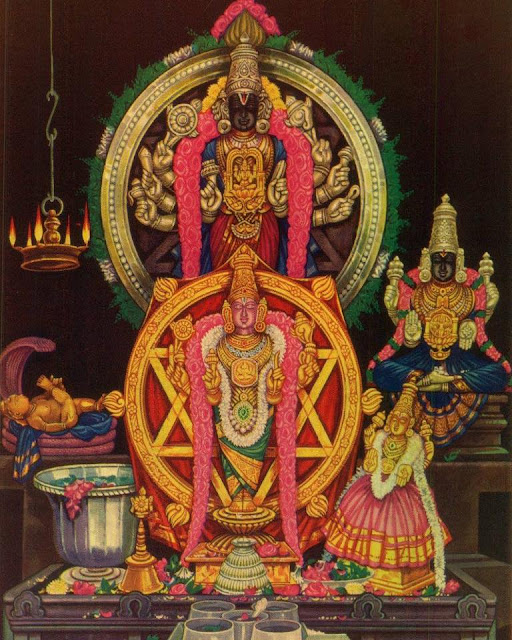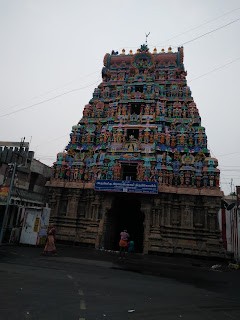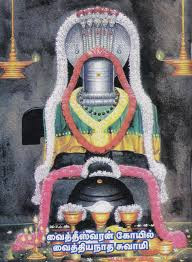KUMBAKONAM TEMPLE VISITS
Kumbakonam was once the capital for Chola kings and many temples were built during the Chola period in and around Kumbakonam. It is 38 kms away from Thanjavur, another place served as capital for cholas. The town is situated on the Southern Bank of Cauvery river and famous for the temple sculptures of the Chola period, general arts and music and was rich due the fertile lands around river cauvery. Many of the brass idols as well as Panchaloga of temples and pooja materials are made here. Nadaswarams are made in Narasingapettai near Kumbakonam. Besides Fllute, Mirudangam and other percussion instruments are also made in the Thanjavur- Kumbakonam belt.
Map showing Trichy, Kumbakonam and Mayiladuthurai (Mayuram)
Nadaswaram in the making
Sculpting Bronze and Panchaloga idols at Swamimalai
Gopura kalasam 5 1/2 ft
During every year, while we have darshan at Vaitheeswaran Koil (Kulatheivam) and also at Swamimalai, we also go to other temples nearby. The details of some of the temples in which we had darshan at different times have been made as blog posts. Kumbakonam also brings us the memory of Mahamaham tank and the story of the Mahamaham tank is linked with the one of Adhi Kumbeswarar temple, which is in the Big Bazaar street. Very near to this temple is the temple of Sree Ramaswamy, which had Samprokshanam in September 2015. Swamimalai Murugan temple also, some renovation had been done and on the same date in September 2015, here also Samprokshanam was done. Sree Sarangapani temple is also nearby and this temple is one of the pancha ranga Kshetrams in the banks of river cauvery with the first one being Srirangapatna and the last at Indalur, Mayiladuthurai. Chakrapani temple is on the Southern Bank of Cauvery and the only temple on the sountern india where a temple is exclusively built for Sudarshana Chakra. The Kasi Viswanathar temple here is famous as Guru and Chandran prayed here. Rajendra Cholans lieutunants brought a Ganesha Statue which is installed in the Arthamandapa of Sree Nageswara Swamy temple. With more than 80 temples, Kumbakonam is known as City of temples. Above all, Mahamaham is celebrated every 12 years, the last one being in 2015. Details on the Kumbam and Nectar and how the spilled Nectar was finally turned into Mahamaham tank can be seen in details given in the blog posting on Adhi Kumbeswarar.
It is said that out of the 274 Thevara Sthalams, 127 are on the Southern Banks of Cauvery River and out of which 3 are in Kumbakonam itself and more than 10 temples within 15 kms from Kumbakonam.
Mahamaham 2015
While the above temples are within the town of Kumbakonam, there are other temples to be seen which are within 15 kms from Kumbakonam. The blog posts so for that had been in this category are:
Sree Garbarakshambigai, Thirukarugavur
Satchinathar, Thirupurambiam
Sree Durgai Amman, Patteeswaram
Sree Prananatheswarar temple, Thirumangalakudi
(Links of other temples will be added in future, after posting details on those temples)
The following links of my blog postings will be useful to have details on individual temples near Kumbakonam
1. Sree Garbarakshambikai, Thirukarugavur
http://sarayutoayodhya.blogspot.in/2016/06/garbaratchambigai-of-thirukarugavur.html
2. Satchinathar temple, Thirupurambiam
http://sarayutoayodhya.blogspot.in/2015/11/blog-post.html
Kumbakonam was once the capital for Chola kings and many temples were built during the Chola period in and around Kumbakonam. It is 38 kms away from Thanjavur, another place served as capital for cholas. The town is situated on the Southern Bank of Cauvery river and famous for the temple sculptures of the Chola period, general arts and music and was rich due the fertile lands around river cauvery. Many of the brass idols as well as Panchaloga of temples and pooja materials are made here. Nadaswarams are made in Narasingapettai near Kumbakonam. Besides Fllute, Mirudangam and other percussion instruments are also made in the Thanjavur- Kumbakonam belt.
Map showing Trichy, Kumbakonam and Mayiladuthurai (Mayuram)
Nadaswaram in the making
Sculpting Bronze and Panchaloga idols at Swamimalai
Gopura kalasam 5 1/2 ft
During every year, while we have darshan at Vaitheeswaran Koil (Kulatheivam) and also at Swamimalai, we also go to other temples nearby. The details of some of the temples in which we had darshan at different times have been made as blog posts. Kumbakonam also brings us the memory of Mahamaham tank and the story of the Mahamaham tank is linked with the one of Adhi Kumbeswarar temple, which is in the Big Bazaar street. Very near to this temple is the temple of Sree Ramaswamy, which had Samprokshanam in September 2015. Swamimalai Murugan temple also, some renovation had been done and on the same date in September 2015, here also Samprokshanam was done. Sree Sarangapani temple is also nearby and this temple is one of the pancha ranga Kshetrams in the banks of river cauvery with the first one being Srirangapatna and the last at Indalur, Mayiladuthurai. Chakrapani temple is on the Southern Bank of Cauvery and the only temple on the sountern india where a temple is exclusively built for Sudarshana Chakra. The Kasi Viswanathar temple here is famous as Guru and Chandran prayed here. Rajendra Cholans lieutunants brought a Ganesha Statue which is installed in the Arthamandapa of Sree Nageswara Swamy temple. With more than 80 temples, Kumbakonam is known as City of temples. Above all, Mahamaham is celebrated every 12 years, the last one being in 2015. Details on the Kumbam and Nectar and how the spilled Nectar was finally turned into Mahamaham tank can be seen in details given in the blog posting on Adhi Kumbeswarar.
It is said that out of the 274 Thevara Sthalams, 127 are on the Southern Banks of Cauvery River and out of which 3 are in Kumbakonam itself and more than 10 temples within 15 kms from Kumbakonam.
Mahamaham 2015
While the above temples are within the town of Kumbakonam, there are other temples to be seen which are within 15 kms from Kumbakonam. The blog posts so for that had been in this category are:
Sree Garbarakshambigai, Thirukarugavur
Satchinathar, Thirupurambiam
Sree Durgai Amman, Patteeswaram
Sree Prananatheswarar temple, Thirumangalakudi
(Links of other temples will be added in future, after posting details on those temples)
The following links of my blog postings will be useful to have details on individual temples near Kumbakonam
1. Sree Garbarakshambikai, Thirukarugavur
http://sarayutoayodhya.blogspot.in/2016/06/garbaratchambigai-of-thirukarugavur.html
2. Satchinathar temple, Thirupurambiam
http://sarayutoayodhya.blogspot.in/2015/11/blog-post.html
3. Prananatheswarar temple, Thirumangalakudi near Aduthurai
http://sarayutoayodhya.blogspot.in/2012/11/thirumangalakudi.html
4. Sree Durgai, Pattesswaram
http://sarayutoayodhya.blogspot.in/2012/11/patteeswaram-patteswaram-near.html
5. Kumbabhishekam of Sree Ramaswamy and Sree Murugan, Swamimalai on same day of 9th september 2016
http://sarayutoayodhya.blogspot.in/2015/09/kumbabishekam-and-samprokshanam-09-09.html
6. Sree Adhi Kumbaeswarar Temple
http://sarayutoayodhya.blogspot.in/2016/10/adhi-kumbeswarar-temple-kumbakonam.html
7. Sree Ramaswami Temple
http://sarayutoayodhya.blogspot.in/2016/10/sree-ramaswamy-temple-kumbakonam.html
8. Sarangapani temple
http://sarayutoayodhya.blogspot.in/2016/10/sree-sarangapani-temple-
kumbakonam.html
9. Chakrapani temple
http://sarayutoayodhya.blogspot.in/2016/10/sree-chakrapani-temple-kumbakonam.html
10. Sree Karkadeswarar Koil, Thiruthevangudi,
http://sarayutoayodhya.blogspot.in/2016/11/thiru-karkadeswarar-temple.html
11. Sree Sivayoginathar temple, Tiruvisainallur
http://sarayutoayodhya.blogspot.in/2016/11/thiru-sivayoginathar-temple.html
12. Sree Nageswarar temple,Keezhakottam,
4. Sree Durgai, Pattesswaram
http://sarayutoayodhya.blogspot.in/2012/11/patteeswaram-patteswaram-near.html
5. Kumbabhishekam of Sree Ramaswamy and Sree Murugan, Swamimalai on same day of 9th september 2016
http://sarayutoayodhya.blogspot.in/2015/09/kumbabishekam-and-samprokshanam-09-09.html
6. Sree Adhi Kumbaeswarar Temple
http://sarayutoayodhya.blogspot.in/2016/10/adhi-kumbeswarar-temple-kumbakonam.html
7. Sree Ramaswami Temple
http://sarayutoayodhya.blogspot.in/2016/10/sree-ramaswamy-temple-kumbakonam.html
8. Sarangapani temple
http://sarayutoayodhya.blogspot.in/2016/10/sree-sarangapani-temple-
kumbakonam.html
9. Chakrapani temple
http://sarayutoayodhya.blogspot.in/2016/10/sree-chakrapani-temple-kumbakonam.html
10. Sree Karkadeswarar Koil, Thiruthevangudi,
http://sarayutoayodhya.blogspot.in/2016/11/thiru-karkadeswarar-temple.html
11. Sree Sivayoginathar temple, Tiruvisainallur
http://sarayutoayodhya.blogspot.in/2016/11/thiru-sivayoginathar-temple.html
12. Sree Nageswarar temple,Keezhakottam,
http://sarayutoayodhya.blogspot.in/2016/11/sree-nageswarar-temple-kumbakonam.html
13. Sree Banapureeswarar temple, Kumbakonam
http://sarayutoayodhya.blogspot.in/2016/11/sree-banapureeswarar-temple-kumbakonam.html
14. Sree Airavatheswarar temple, Darasuram
http://sarayutoayodhya.blogspot.in/2016/12/sree-airavatheswarar-darasuram.html
15. Sree Kasi Viswanathar Temple near Mahamahakulam, Kumbakonam
http://sarayutoayodhya.blogspot.in/2017/01/sree-kasi-viswanathar-temple-kumbakonam.html
16. Sree Abimukeswarar Temple near Mahamhakulam, Kumbakonam
http://sarayutoayodhya.blogspot.in/2017/01/sree-abhimukeswarar-temple-kumbakonam.html
17, SREE VISWANATHAR TEMPLE, THEPPERUMANALLUR
https://sarayutoayodhya.blogspot.com/2019/10/sree-kasi-viswanathar-temple.html
18. Sree Swaminathaswamy Swamimalai
https://sarayutoayodhya.blogspot.com/2018/05/sree-swaminatha-swamy-swamimalai.html
19. Sree Umamaheswarar Konerirajapuram near Kumbakonam
https://sarayutoayodhya.blogspot.com/2019/10/sree-umamaheswarar-konerirajapuram-near.html
13. Sree Banapureeswarar temple, Kumbakonam
http://sarayutoayodhya.blogspot.in/2016/11/sree-banapureeswarar-temple-kumbakonam.html
14. Sree Airavatheswarar temple, Darasuram
http://sarayutoayodhya.blogspot.in/2016/12/sree-airavatheswarar-darasuram.html
15. Sree Kasi Viswanathar Temple near Mahamahakulam, Kumbakonam
http://sarayutoayodhya.blogspot.in/2017/01/sree-kasi-viswanathar-temple-kumbakonam.html
16. Sree Abimukeswarar Temple near Mahamhakulam, Kumbakonam
http://sarayutoayodhya.blogspot.in/2017/01/sree-abhimukeswarar-temple-kumbakonam.html
17, SREE VISWANATHAR TEMPLE, THEPPERUMANALLUR
https://sarayutoayodhya.blogspot.com/2019/10/sree-kasi-viswanathar-temple.html
18. Sree Swaminathaswamy Swamimalai
https://sarayutoayodhya.blogspot.com/2018/05/sree-swaminatha-swamy-swamimalai.html
19. Sree Umamaheswarar Konerirajapuram near Kumbakonam
https://sarayutoayodhya.blogspot.com/2019/10/sree-umamaheswarar-konerirajapuram-near.html
20. SREE AGNEESWARAR TEMPLE, KANJANUR
https://sarayutoayodhya.blogspot.com/2022/02/sree-agneeswarar-temple-kanjanur.html












































